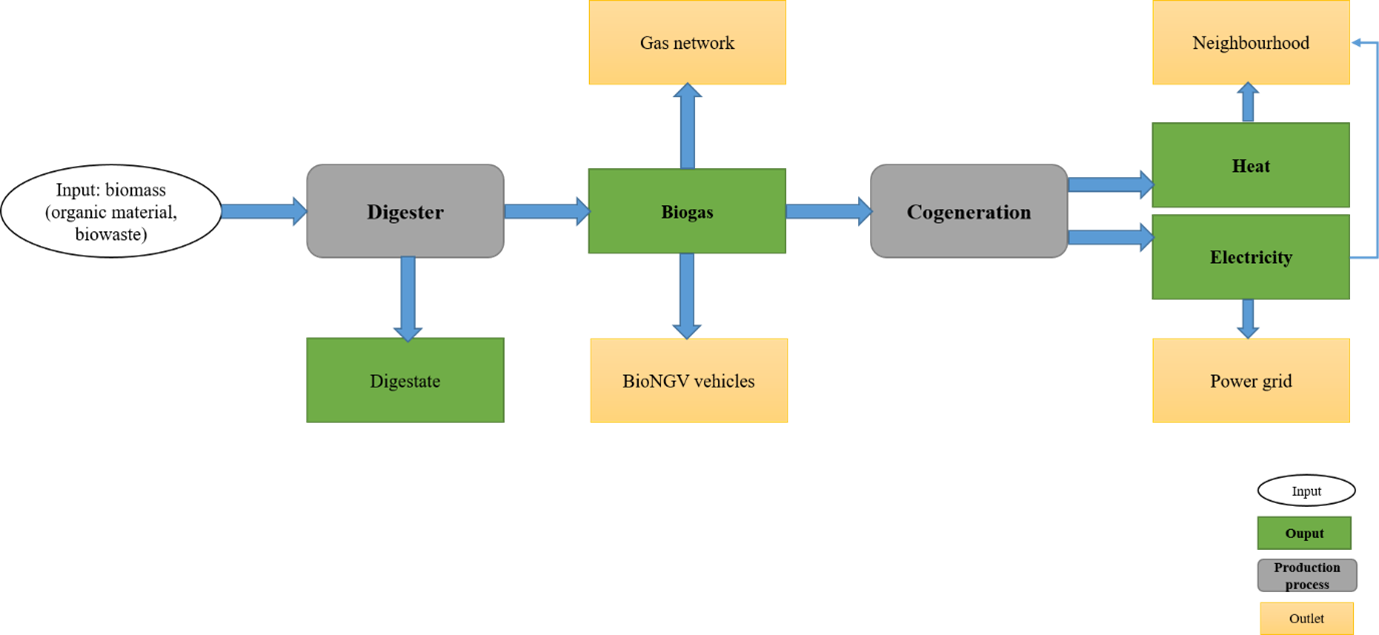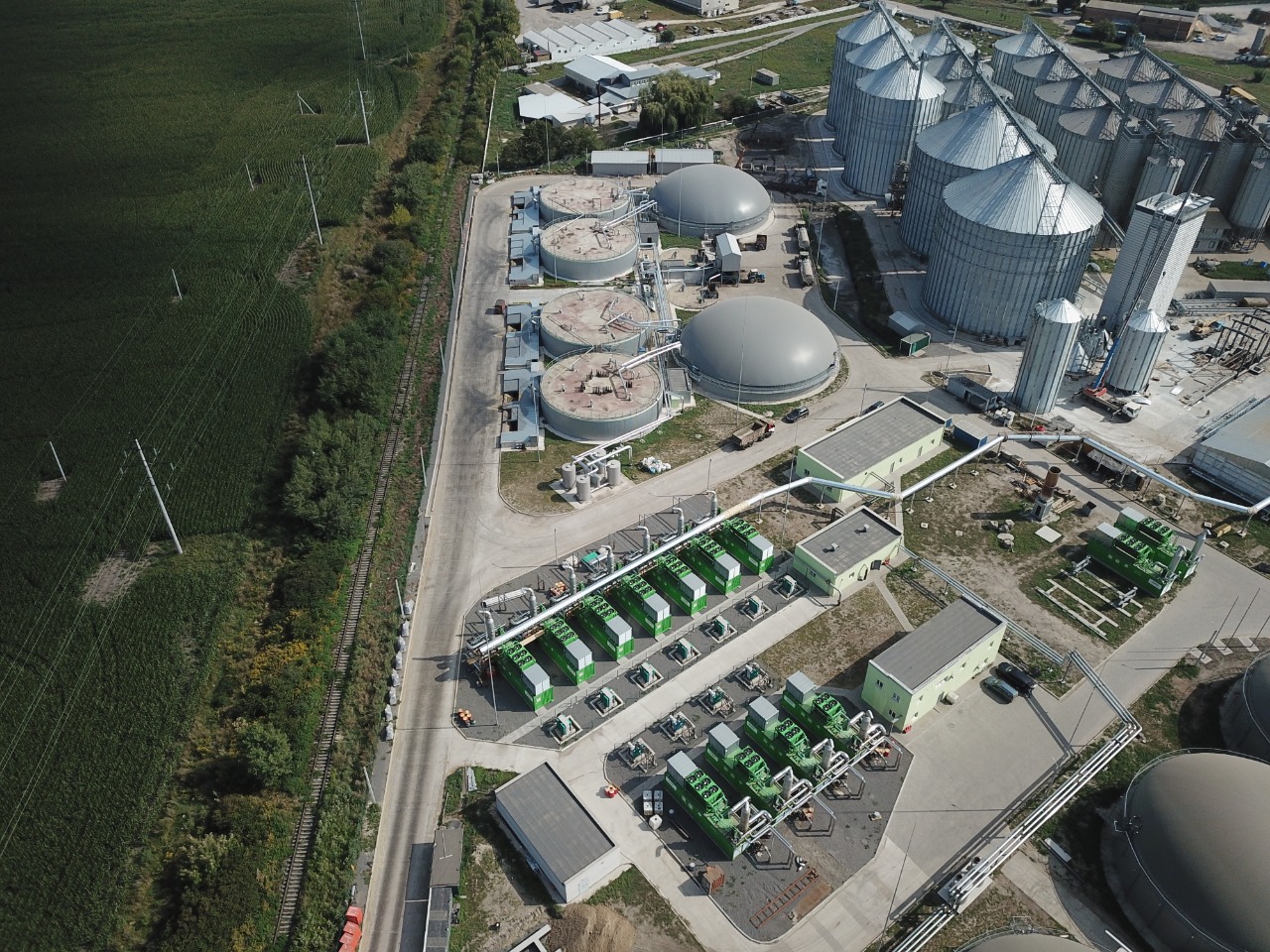We often consider renewable energy exclusively through the prism of the sun and wind. However, biomass energy is one of the key renewable sources, coming from direct biomass burning or anaerobic digestion (methanization). And the production of biogas is currently an extremely important and promising direction due to the need to replace large volumes of russian gas with biomethane.
Biogas plants are mostly located in rural areas and around farms. These are large closed tanks, anaerobic digestion reactors that convert biomass, such as agricultural biowaste, into energy. This is the process of anaerobic fermentation, when “biomass is broken down by naturally occurring microorganisms in the absence of oxygen” releasing methane-rich biogas.
Anaerobic digestion to generate biogas – The process in a nutshell
- Biomass in incorporated into a digester where chemical and biological reactions are carried out. This biomass includes organic material such as wastewater biosolids, food wastes, agricultural wastes, and principally livestock manure;
- Microorganisms, such as bacteria and archaea, digest this biomass. Therefore, biogas is released. It is a gas composed mostly of bio-methane (CH4) and carbon dioxide (CO2).
- After this process, there is still a remaining material in the digester, called digestate. This is a residual material left after the process, which is a liquid and solid digested material. As it is nutrient-rich, it can be used as a fertiliser.
- The methane- and carbon dioxide-rich biogas can finally be used as transportation fuel or electricity with heat generation.
Anaerobic digestion process

Currently, the question arises whether small-scale biogas production, micromethanization, can be a sustainable energy solution for cities in the future.
By converting bio waste into resources, anaerobic digestion improves the circular economy in a territory, while producing a renewable energy. Thus, it helps mitigate climate change and highlights the need of this kind of interactions between agriculture, the energy sector, and climate change.
As most of the digester’s input (biomass) is located outside of the cities, anaerobic digestion takes place mostly in rural areas. However, the valorisation of urban bio-waste could play an important role in reducing cities’ environmental impacts – that usually increase hand in hand with the population.
Some solutions have been developed, such as micro-methanisation, which is the anaerobic digestion process with a limited size, allowing digesters to get in urban areas. Nevertheless, micro-methanisation in urban area raises many questions regarding the size of the digester, the inputs, and the outlets.
Dr. Jean-Romain Bautista Angeli, an expert in anaerobic digestion of urban waste and involved in the MELiSSA project, a European-funded project on circular life support systems in space, presented his point of view to the European Science-Media Hub.

What are the limits of micro-methanisation in an urban environment?
Dr. Jean-Romain Bautista Angeli:
Anaerobic digestion is a valuable process only if it produces energy as well as nutrients (the digestate) that will both be recovered. A double valorisation of the energy and the nutrients are two pre-conditions that need to be fulfilled for anaerobic digestion to be interesting. Hence, in an urban environment, it is important to find an outlet for both the energy and the digestate, which can be difficult for the latter. Moreover, if this outlet was not closed to the place of production and would need to be transported, it would be counterproductive.
Anaerobic digestion is a process that, especially on a small scale, can be unstable: the more you increase the volume, the better you control it. Moreover, this process is not easy to manage: it is a microbiological process which requires some expertise, skills, and training to be optimised.
Additionally, many stakeholders and players are involved in this process: anaerobic digestion requires multiparty actors to develop this kind of process in an urban context. Hence, it requires a strict collaboration among them, and this may raise questions about the ease of developing this kind of technology on an urban scale.
Last but not least, there is a limit about whether we use wastewater or not in this process. Indeed, if the digester’s input is only composed of bio-waste, many things can be done with it before considering anaerobic digestion, as the output may conflict with EU waste hierarchy.
Biomass, biogas and anaerobic digestion in EU legislation
- The Renewable Energy Directive 2018/2001 establishes sustainability criteria and greenhouse gas emissions saving criteria for biomass;
- the Regulation on Land Use, Land Use Change and Forestrysets out safeguards on bioenergy, and makes sure that all sectors contribute to the EU’s 2023 emission reduction target;
- the EU’s Biodiversity Strategy for 2030 considers that the intense use of biomass to produce bioenergy should be minimised, not to have a conflict of interest on the use of these materials;
- the Nutrient Action Plan for better management;
- the Waste Framework Directive establishing a waste hierarchy in the EU.
Moreover, there is a strong willingness in the EU to reduce food waste: there may not be consistency in creating an energy production unit dependent on food waste that we are trying to reduce. Conversely, if wastewater is part of the anaerobic digester’s input, there is no need to always provide the digester with bio-waste. Hence, the digester is always relevant, as households will continue to produce wastewater anyway. Nevertheless, this involves more players and stakeholders, so the complexity in terms of regulations is greater.
Do you think that the size of digesters can be a limit to micro-methanisation in urban areas?
Dr. Jean-Romain Bautista Angeli:
In the case of micro-methanisation, what matters is the notion of a decentralised and autonomous system in a given area.
There are actually digesters that work at the house scale. Nevertheless, these digesters need a minimum quantity of bio-waste as input to work: even if they have a small capacity, they require a substantial daily input of organic matter. Is a single family able to produce this amount of waste, keeping in mind the need to reduce food waste? It is therefore necessary to find a biogas plant that is consistent with a local input and production capacity.
What are the opportunities related to micro-methanisation in urban areas?
Dr. Jean-Romain Bautista Angeli:
The most important impact of micro-methanisation in urban areas is the production of green energy, while making virtuous water and nutrient loops. As an example, a wastewater treatment plant has its own specific advantages but costs energy to work; conversely, a digester produces energy and is self-powered: it only produces energy benefits. This process could also have a direct impact on people’s financial resources, as the heat and electricity produced in this process can reduce energy bills.
For a long time, there has been this idea that waste is a dirty thing from which we must move away. With anaerobic digesters in their buildings, people can convert their waste into biogas and then they will consume this biogas they just produced thanks to their waste. This way we can reconnect people with the notion of waste, but also with the notion of resources. Anaerobic digestion in urban areas can have this social approach and reconnect people with waste, resources, and the impact of their way of living.
Finally, we talk more and more about urban forests, self-sustaining cities, and urban farms. These projects require nutrients to be sustainable. Hence, anaerobic digestion in urban areas could be relevant to provide this kind of city with its needs.
Are the outlets for biogas produced in urban areas the same as in agricultural areas?
Dr. Jean-Romain Bautista Angeli:
Given current technologies, urban micro-methanisation is only approached from the angle of cogeneration. To be injected in the gas network, or to be used in a bioNGV vehicle [a vehicle using biogas as fuel], biogas needs to be upgraded in order to reach the desired percentage of methane; however, this process costs too much energy and money.
Thus, urban micro-methanisation’s outlets are mainly heat and electricity consumed in the household. Actually, even cogeneration can be a complicated process, especially for motors that produce heat and electricity at low output. The energy amount is especially relevant that the production of heat could be 5 times higher than the production of electricity. In this sense, the installation of anaerobic digestion near the final users looks crucial.
Currently, we only envisage a recovery in the energy form of the biogas, but actually, this biogas could return to a more nutritional sphere and be closer to the digestate.
What do we do with this digestate?
Dr. Jean-Romain Bautista Angeli:
Actually, it is possible to transport it outside of the cities, it depends on where the digester is located: downtown, closed to the outskirts… It also depends on the size and the nature of the biomass. If it involves wastewater, volumes are larger. Nevertheless, if the input is only bio-waste, volumes are smaller and easier to be transported. The most important thing is to not multiply the transports. If the objective is to create the city of tomorrow, which is a self-sustaining city that needs nutrients, it is worth it. If we do not need nutrients, other solutions must be found.
What is the level of social acceptability of anaerobic digestion in urban areas?
Dr. Jean-Romain Bautista Angeli:
Anaerobic digestion never makes people neutral: there are always pros and cons, and many debates. There is an important work to do around raising awareness to make people define the real benefits and limits so that everyone can find their answers and can make informed choices. Some people are afraid about nuisance coming from this process, and in some cases, they are right.
However, if a digester causes nuisance, it is generally only because it is badly managed. For instance, the digestate smells less than the input of the digester. Smells only come from upstream waste storage, or later if the digestate is badly managed. People need to understand that the danger is related to any industrial process, and there is not supposed to be a particular danger related to anaerobic digestion.
The more you raise awareness about this process, the more it will be socially accepted. Anaerobic digestion could probably only happen and work if people really want it and find benefits in the process.
Source: European Science-Media Hub
Image: Waste Management World; Zorg Biogas